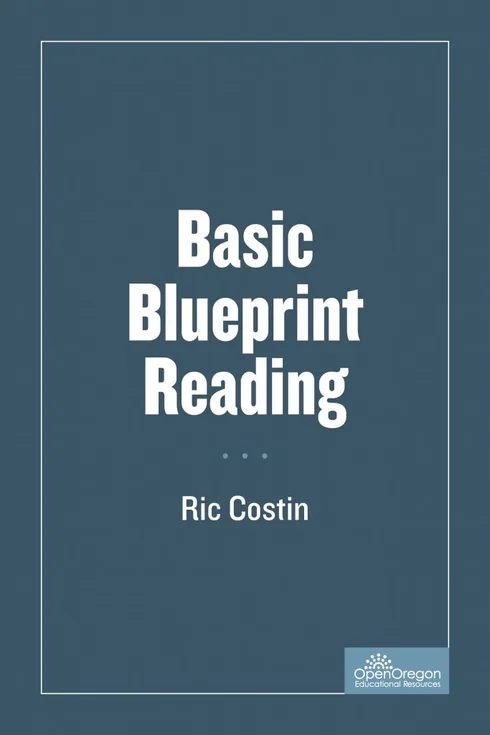
Basic Blueprint Reading
![]()
![]()
![]()
![]()
![]()
Ric Costin, Linn-Benton Community College
Copyright Year:
ISBN 13: 9781636350318
Publisher: Open Oregon Educational Resources
Language: English
Formats Available
Conditions of Use
![]() Attribution
Attribution
CC BY
Reviews
Reviewed by Patrick Stone, Adjunct Professor, Trine University on 4/19/21
Regarding the author's attempt to cover the material and meet the author's stated goal of familiarizing first year welding students with how to sketch and read blueprints, the author has succeeded in every way. The book covers all the needed... read more
![]()
![]()
![]()
![]()
![]()
Reviewed by Patrick Stone, Adjunct Professor, Trine University on 4/19/21
Comprehensiveness
Regarding the author's attempt to cover the material and meet the author's stated goal of familiarizing first year welding students with how to sketch and read blueprints, the author has succeeded in every way. The book covers all the needed areas (everything from basic blueprint reading to terminologies used in real world applications to interpretation of prints). The text is written in simple language which makes it very easy to understand, particularly for its target audience (first year students that likely have little background or knowledge in this area).
Content Accuracy
I found no bias built into this book. While I did find that sometimes the terminology was used mixed together, that terminology was still accurate. An example would be words like "drawing" and "blueprint" and how they are used interchangeably in the text but never really stated that they mean the same thing.
Relevance/Longevity
I found the content to be extremely relative. In my career, when we hire new people into my department, we have to give them blueprint training so that they will understand how to read and interpret blueprints. This text is far superior and more comprehensive that the training we give them. I am confident that if we gave them this training, we would have better success and the new employees would have far better understanding of blueprints. I found no evidence of outdated material or topics that will be obsolete in the near future.
Clarity
Yes! As mentioned before, the text is written simply so that it is clear for someone who has not had any training or experience with blueprints. I find this very helpful for students when learning new subjects. If you can keep the text clear and focus on the new terminology they are learning as a part of the book, they will have an easier time understanding the topics covered.
Consistency
The text is consistent and follows a logical path through learning the basics of blueprints (from introduction of the basics to complex interpretation of them). There are a few cases where terminology is used interchangeably without the author specifically stating that the two terms mean the same thing.
Modularity
The text includes chapter headings and subheadings which make it easy to see where one section starts and another section ends. One minor issue is that the images do not have figure numbers so they cannot be easily referenced. However, the images tend to be within the body of the text, so the figure numbers would just make it easy when the author wants to reference something you've already reviewed.
Organization/Structure/Flow
As mentioned before, the topics covered are in the right order and aid the learner from a basic understanding all the way to complex skills.
Interface
This is probably my largest issue with the text. In the PDF version, many of the images are grainy and do not look crisp or clear. This is most likely due to the source of the image being low quality or dpi and the image size being increased within the text. There are also a few blueprints that have details very small and are hard to see even when zoomed in. However, the author does state that the instructor will be handing out a copy of the blueprint and I assume that this would be printed on larger paper (something like 11x17).
Grammatical Errors
I found no major grammatical errors. There were a few instances of word choice that made the reader stumble and a few other minor formatting issues.
Cultural Relevance
I found no evidence of cultural biases in the book or anything that should be found as offensive.
CommentsI think this book can be used for more than just first year welding students. For anyone interested in learning the basics of blueprints (how to read them, how to identify parts of a blueprint, and how to interpret blueprints), I would highly recommend this book. I can see it being used in manufacturing plants where operators or quality inspectors need a basic understanding of blueprints.
Table of Contents
- 1. Cover
- 2. The Language of Lines
- 3. Visualization
- 4. Technical Sketching
- 5. Scaling
- 6. Dimensioning
- 7. Auxiliary Views
- 8. Sectional Views
- 9. Machined Features
- 10. Print Interpretation
About the Book
This is an entry level blueprint reading book written for the first year welding student. The book will be used in the first term of a two year welding program to familiarize the student to sketching and reading blueprints.
About the Contributors
Author
Ric Costin, Linn-Benton Community College
